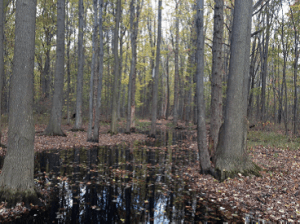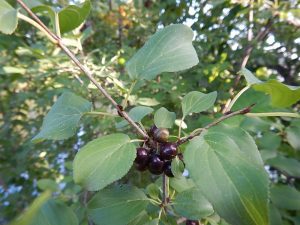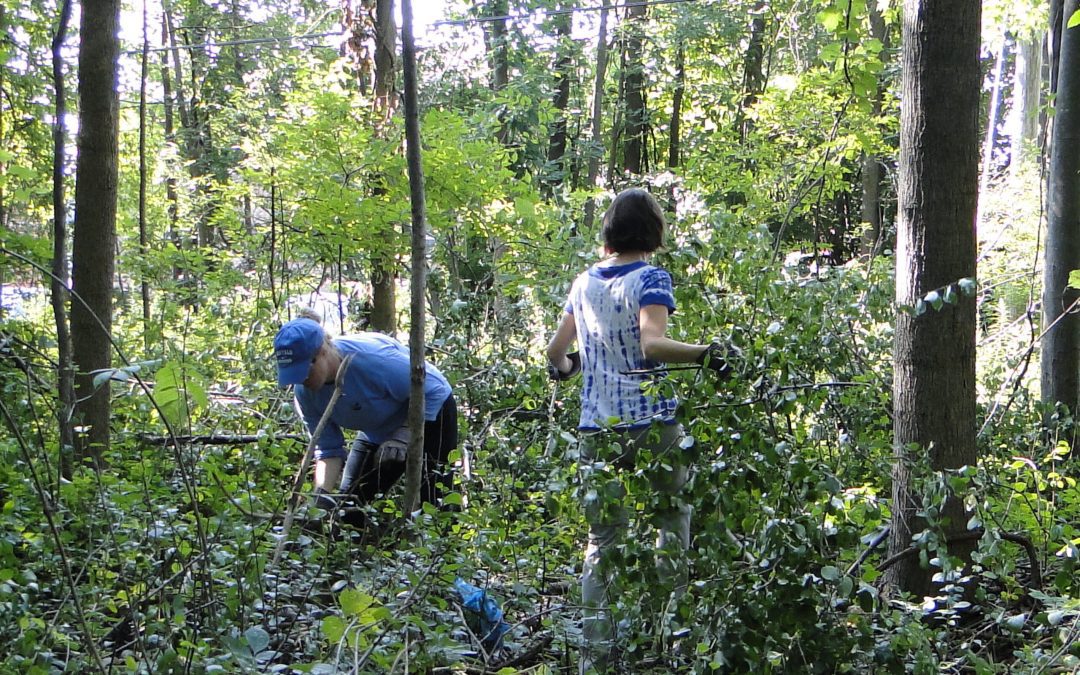
WNY PRISM works alongside volunteers to remove invasive shrubs from North Tonawanda Audubon Preserve, August 2017. Photo Credit: WNY PRISM.
When most people think of a nature preserve, they think of an area out in the middle of nowhere, away from the hustle and bustle of human life. Most of the time they are correct, however there are times when this is not the case. This is true for the North Tonawanda Audubon Nature Preserve, also referred to as Klydel Wetlands. This diamond in the rough is located in an area surrounded by housing developments and other forms of human development. But, this doesn’t detract from its beauty and need for continued protection and management so it may be enjoyed by current and future generations.

A shallow pool within the forested wetland provides valuable habitat for amphibians and other wildlife. Photo Credit: Buffalo Niagara Riverkeeper.
Over the years, several organizations have come together to help preserve this wetland for public enjoyment. Owned and managed by Buffalo Audubon Society, Western New York Land Conservancy and City of North Tonawanda, the near 70 acre wetland makes one of the largest contiguous urban ecosystems left in Western New York. Hosting hundreds of species of native flora and fauna, it is also an important area for migrating birds. In the spring you’ll find vernal pools, which provide essential habitat for frogs, salamanders and other species to breed and survive. The forested area is also home to many mature trees and native shrubs. The unique assemblage of species and habitats, combined with the preserves location and relatively small size, make invasive species management and restoration efforts necessary in order to preserve and enhance the quality of this site.

Common Buckthorn (Rhamnus cathartica) berries. photo credit: Andrea Locke, WNY PRISM
In 2014, an assessment of Klydel wetlands determined that up to 50% of the area may be covered in invasive species. While this may seem like a lot, it is not uncommon for natural areas in the western New York region, especially those near urban centers. In response to the need for management and restoration, WNY PRISM has partnered with Buffalo Audubon Society to assist with invasive species removal efforts at the North Tonawanda Audubon Nature Preserve. Work started in 2016, with WNY PRISM conducting an invasive species survey of the site, to get a better idea of species presence and distribution, and continued with developing a management plan and obtaining necessary permits to conduct removal efforts. With the permit and plans in hand, WNY PRISM started with removal of invasive shrubs in August, 2017. The WNY PRISM Crew’s focus was on common buckthorn, but we also handled populations of japanese barberry, bush honeysuckle and multi-flora rose. The method of removal we used was cut-stump, which involves cutting the stem using loppers and applying an herbicide to the freshly exposed surface, to prevent re-sprouting. Instead of simply leaving the stems where they fell, we stacked them up in a number of smaller piles to form hibernaculum. Hibernaculum provide hibernating animals and insects with a safe winter space, protecting them from predators. On our final day on site, we were lucky to be joined by several local volunteers and Great Lakes Today reporter, Angelica Morrison, who spoke with us about the project!
Overall, the project at the North Tonawanda Audubon Nature Preserve was rewarding in several different ways. Not only were we able to make inroads against the invasive threat to the area, it was also wonderful to have the public involved. While we do our best to combat invasive species, we could never be successful without support from every day citizens. Managing natural areas is an important aspect in maintaining a healthy ecosystem, and seeing your results and efforts positively influence both nature and the community always helps give an extra feel good boost at the end of the day.
This article was written by Kevin Sanders, 2017 WNY PRISM Invasive Species Management Assistant.


